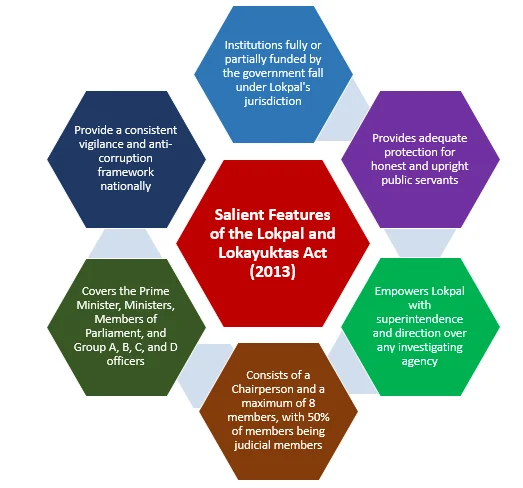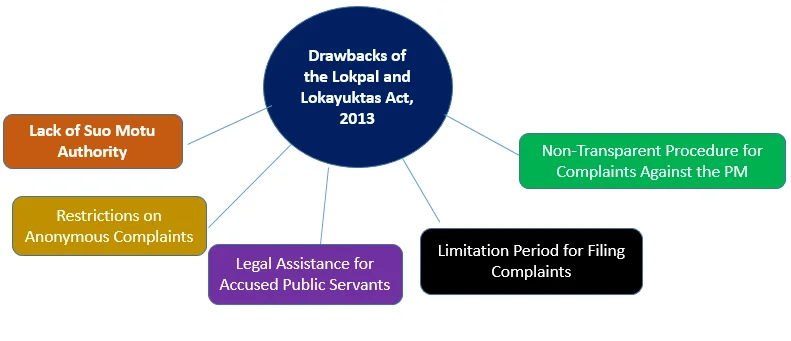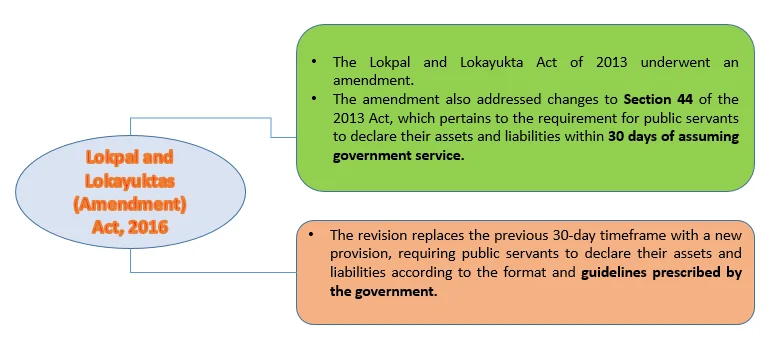In democratic societies, the government’s role in welfare and development has expanded, giving rise to an empowered bureaucracy. However, this increase in administrative power has sometimes led to abuses, maladministration, and corruption. To address citizens’ grievances and ensure accountability, India has adopted mechanisms like the Lokpal and Lokayuktas, inspired by the Ombudsman model.
Lokpal and Lokayuktas
Institutional Devices for Grievance Redressal
- The Ombudsman System:
-
-
- The Ombudsman institution originated in Sweden in 1809. The term “Ombud” means a representative or spokesman for another person.
- Ombudsman is an officer appointed by the legislature to address complaints against administrative and judicial actions. It handles citizens’ grievances related to:
- Abuse of administrative discretion.
- Maladministration, indicating inefficiency.
- Administrative corruption, involving bribery.
- Nepotism, favoring relatives in matters like employment.
- Discourtesy, such as the use of abusive language.
- Constitutional Authority of the Ombudsman: The Ombudsman has constitutional authority to oversee the compliance of laws and regulations by public officials and ensure their proper discharge of duties.
- Complaint Handling and Suo Motu Powers: The Ombudsman acts on complaints or suo motu (own initiative) and can report matters to higher authorities for corrective action.
- Global Reach of the Ombudsman Institution: The institution has spread to several countries, including Finland, Denmark, Norway, New Zealand, and the United Kingdom.
- India’s Adaptation: India has a similar institution called Lokpal/Lokayukta.
-
- Administrative Courts System: The French system of Administrative Courts provides a unique mechanism for redressing citizens’ grievances against administrative authorities.
-
-
- Originating in France, this system has been adopted by various other countries.
-
- Procurator System: Socialist countries like the former USSR (now Russia) and China have established the Procurator System.
-
- These institutional devices serve as essential tools for citizens to seek redressal for grievances related to administrative actions and decisions.
- They provide a means of oversight and accountability, promoting fair and just administrative practices.
Establishment of Lokpal and Lokayukta
- The First Administrative Reforms Commission (ARC) of India, active from 1966 to 1970, proposed the establishment of two special authorities: ‘Lokpal’ and ‘Lokayukta,’ modeled after the Scandinavian institution of Ombudsman and the parliamentary commissioner for investigation in New Zealand. The key responsibilities of these institutions were as follows:
- Lokpal: Address complaints against ministers and secretaries at both Central and state levels.
- Lokayukta: Deal with complaints against other specified higher officials at the state level.
- Exclusions: The judiciary was excluded from the purview of Lokpal and Lokayukta, following the New Zealand model.
- In contrast, in Sweden, the judiciary falls within the Ombudsman’s jurisdiction.
- Appointment Process: The ARC recommended that the President would appoint the Lokpal after consultation with the Chief Justice of India, the Speaker of Lok Sabha, and the Chairman of the Rajya Sabha.
- Key Features Recommended by the ARC:
-
-
- Ensuring demonstrable independence and impartiality.
- Conducting investigations and proceedings in private and maintaining an informal character.
- Striving for non-political appointments.
- Elevating their status to be on par with the highest judicial functionaries in the country.
- Dealing with discretionary matters involving acts of injustice, corruption, or favoritism.
- Exempting their proceedings from judicial interference.
- Granting maximum latitude and powers for obtaining relevant information.
- Ensuring that they do not expect any benefits or pecuniary advantages from the executive government.
-
- Enactment of Lokpal and Lokayuktas Act:
-
- The first four bills lapsed due to the dissolution of the Lok Sabha, while the fifth bill was withdrawn by the government.
- The sixth and seventh bills also lapsed due to the dissolution of the 11th and 12th Lok Sabha.
- The eighth bill (2001) lapsed due to the dissolution of the 13th Lok Sabha in 2004.
- The ninth bill (2011) was withdrawn by the government.
- The tenth bill, known as the Lokpal and Lokayuktas Bill, 2011, was enacted as the Lokpal and Lokayuktas Act, 2013, marking a significant milestone in the establishment of these institutions in India.
Salient Features of the Lokpal and Lokayuktas Act (2013)

- Uniform Vigilance and Anti-Corruption Roadmap: Establishes the institutions of Lokpal at the Centre and Lokayukta at the state level to provide a consistent vigilance and anti-corruption framework nationally.
- Lokpal’s Jurisdiction: Covers the Prime Minister, Ministers, Members of Parliament, and Group A, B, C, and D officers and officials of the Central Government.
- Composition of Lokpal: Consists of a Chairperson and a maximum of 8 members, with 50% of members being judicial members.
- Inclusiveness: Requires 50% of Lokpal members to come from Scheduled Castes (SCs), Scheduled Tribes (STs), Other Backward Classes (OBCs), minorities, and women.
- Appointment Process: Selection of Chairperson and members by a Selection Committee comprising the Prime Minister, Speaker of the Lok Sabha, Leader of the Opposition in the Lok Sabha, Chief Justice of India, or a sitting Supreme Court Judge nominated by the Chief Justice, and an eminent jurist nominated by the President based on recommendations from the first four committee members.
- Search Committee: A Search Committee assists the Selection Committee in the selection process, with 50% of its members representing SCs, STs, OBCs, minorities, and women.
- Inclusion of the Prime Minister: The Prime Minister is brought under the purview of the Lokpal, with specific subject matter exclusions and a defined process for handling complaints against the Prime Minister.
- Broad Jurisdiction: Lokpal’s jurisdiction covers all categories of public servants, including Group A, B, C, and D officers and employees of the government.
- Supervisory Powers: Empowers Lokpal with superintendence and direction over any investigating agency, including the CBI, for cases referred to them.
- Director of CBI Selection: A High-Powered Committee chaired by the Prime Minister recommends the selection of the Director of the Central Bureau of Investigation (CBI).
- Attachment and Confiscation of Property: Allows for the attachment and confiscation of property acquired by public servants through corrupt means, even during pending prosecution.
- Timelines and Special Courts: Three months extendable by three months for preliminary inquiry, six months extendable by six months for investigation, and one year extendable by one year for trial.
- Special courts are to be set up to meet these timelines.
- Punishment Enhancement: Increases the maximum punishment under the Prevention of Corruption Act from seven years to ten years.
- Minimum punishments for various sections are also raised.
- Inclusions and Exclusions: Institutions fully or partially funded by the government fall under Lokpal’s jurisdiction, while institutions aided by the government are excluded.
- Protection for Upright Public Servants: Provides adequate protection for honest and upright public servants.
- Lokpal’s Power to Grant Sanction: Empowers Lokpal to grant sanction for prosecution of public servants instead of the government or competent authority.
- Strengthening the CBI: Implements provisions to enhance CBI’s efficiency, such as setting up a Directorate of Prosecution, maintaining a panel of advocates, officer transfers, and provision of funds for cases referred by Lokpal.
- FCRA Entities Under Lokpal’s Jurisdiction: Entities receiving donations exceeding 10 lakhs per year from foreign sources under the Foreign Contribution Regulation Act (FCRA) are brought under Lokpal’s jurisdiction.
- State Lokayukta: Mandates the establishment of Lokayukta through state legislature enactment within 365 days from the commencement of this Act, allowing states to determine their Lokayukta mechanisms.
Drawbacks of the Lokpal and Lokayuktas Act, 2013

- Lack of Suo Motu Authority: Lokpal cannot initiate proceedings on its own against any public servant, which may limit its ability to address certain cases proactively.
- Emphasis on Complaint Formalities: The Act places more emphasis on the form of the complaint rather than its substance, potentially creating barriers for complainants.
- Deterrence for False Complaints: The Act imposes heavy penalties for false and frivolous complaints against public servants, which might discourage individuals from filing complaints with Lokpal.
- Restrictions on Anonymous Complaints: Anonymous complaints are not permitted, preventing individuals from making complaints informally by submitting them with supporting documents.
- Legal Assistance for Accused Public Servants: The Act allows public servants accused of corruption to seek legal assistance, potentially complicating proceedings and protecting their interests.
- Limitation Period for Filing Complaints: There is a limitation period of seven years to file complaints, which may result in older cases going unaddressed.
- Non-Transparent Procedure for Complaints Against the PM: The process for handling complaints against the Prime Minister (Section 14) is considered non-transparent, potentially affecting accountability and public trust.
Lokayukta
- Structural Variation: The structure of the Lokayukta varies among states. Some states have both Lokayukta and Upa Lokayukta, while others have only the Lokayukta.
- Appointment Process: Lokayukta and Upa Lokayukta are appointed by the Governor of the state.
- Judicial Qualifications: Some states specify judicial qualifications for the Lokayukta, while others do not prescribe specific qualifications.
- Term of Office: In most states, the term of the Lokayukta is five years or up to the age of 65, whichever comes earlier.
- Jurisdiction of Lokayukta varies across states:
-
- In some states, the Chief Minister falls within Lokayukta’s jurisdiction, while in others, the Chief Minister is excluded.
- Ministers and higher civil servants are generally included within Lokayukta’s purview in most states.
- Members of state legislatures are included in the jurisdiction of Lokayukta in some states.
- Initiation of Investigations: Lokayukta in most states can initiate investigations based on citizen complaints against unfair administrative actions or suo motu.
- Scope of Cases: Lokayukta can consider both “grievances” and “allegations” in some states, while in others, they focus only on investigating allegations related to corruption, not grievances about maladministration.
- Annual Report: Lokayukta submits an annual consolidated report to the Governor, who, in turn, presents it along with an explanatory memorandum to the state legislature.
- Advisory Recommendations: Recommendations made by Lokayukta are advisory and not legally binding on the state government.

| Must Read | |
| Current Affairs | Editorial Analysis |
| Upsc Notes | Upsc Blogs |
| NCERT Notes | Free Main Answer Writing |
Conclusion
The Lokpal and Lokayuktas Act of 2013 represents a landmark in India’s efforts to combat corruption and ensure accountability.
- Despite some limitations, these institutions serve as vital checks on administrative power, promoting transparency and fairness in governance while empowering citizens with avenues for redress.
| Related Articles | |
| PART – III (CENTRAL GOVERNMENT) | The Speaker of Lok Sabha |
| Central Bureau of Investigation (CBI) | Lokpal and Lokayuktas in India |

 GS Foundation
GS Foundation Optional Course
Optional Course Combo Courses
Combo Courses Degree Program
Degree Program











